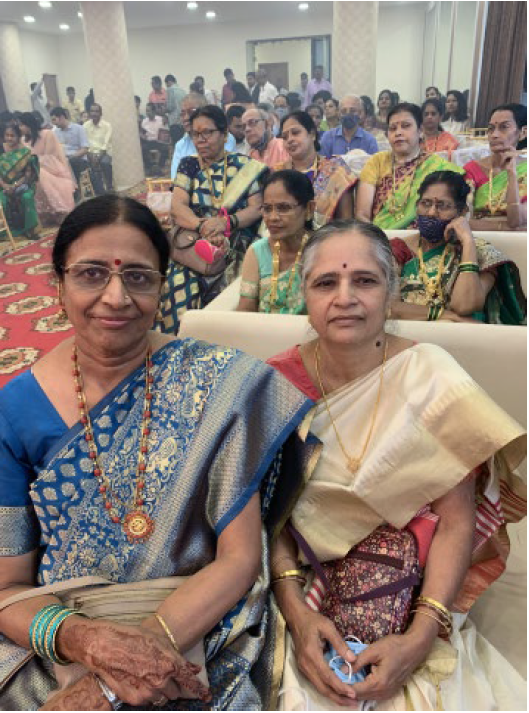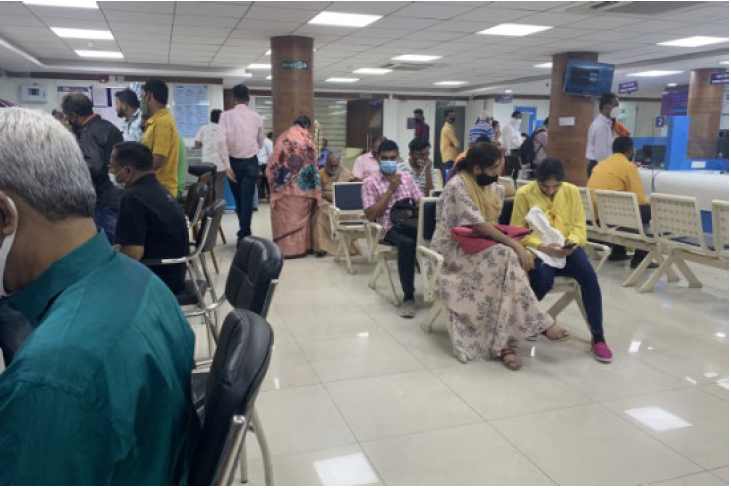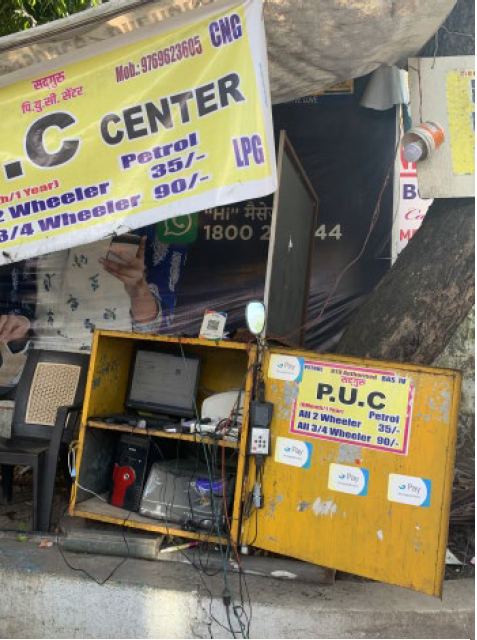I recently took a month-long break in India—in the last 17 years, this was the first time I was so removed from the markets. Whether it was being away from the Bloomberg terminal, or the relaxed attitude that India and Indians have towards everything, or the warmth of family and friends, I must say it was the best and most memorable trip I have had in a long time.
I am now back in Singapore, with a heart stuck in its origins and a brain that has moved on. I always wonder which is better—materialism or inequality, shrewdness or simplicity, efficiency or chaos, conformity or lack of civic sense, flexibility or warped traditions. I think my heart will always yearn for the past (that never was) and hope for a future that never will be. Ah, the dilemmas of an emigrant mind!
Though this was not a business trip, I’d like to share some observations I made while on the ground.
COVID-19 barely features in daily life—but new variants and long COVID are a risk
 Unmasked attendees at a wedding (Source: author)
Unmasked attendees at a wedding (Source: author)
In India, it felt like COVID-19 no longer existed. Masks were around but they have become a garment like a bow tie—usually found below the nose and often around the neck. This is especially surprising because everyone I spoke to had horror stories of deaths, lockdowns, hospital admissions and long COVID symptoms. If the virus continues to mutate, India could be the birthplace of many more variants given the size of its population and the wide diversity of behaviours found within. But if herd immunity and vaccines work, then India is probably already at very high levels of immunity.
As for vaccines, there has been surprisingly better compliance by people of lower economic strata and those living in rural areas. There has been reluctance to take the second dose in urban areas, as COVID fears have waned considerably. Vaccination centres are running empty although only 38% of the population above 18 has been fully vaccinated. That said, higher levels of walk-ins were reported after Omicron fears gripped the country.
Those below 18 are still largely unvaccinated. Given that the age group accounts for a significant proportion of the Indian population, this will have implications if we see more virulent variants.
Long COVID is a big issue—skin rashes, hair fall, abrupt heart rate and blood pressure changes were among the common symptoms I heard about.
While the risk of new waves exists, I doubt that there will be a nation-wide lockdown. Even if region-specific restrictions are implemented, adherence is likely to be low.
Online schooling is the biggest casualty from the lockdown, but women are benefiting from WFH
Everything in India is almost back to normal—restaurants, shopping, weddings on a mass scale—except for schools, which have just started to reopen after two years of lockdowns. Online school, like some online meetings, could be described as a farce; especially when connectivity is poor and devices are being shared by the entire household. The poor don’t even have a good smart phone, let alone a proper internet connection or a screen with which anyone can see or hear a teacher. The long lasting negative socioeconomic impact of online schools is likely to be felt by poorer sections of the society for a long time, and school dropouts may be common. A neighbour’s 9-year-old couldn’t say the 5 times table, a friend’s 14-year-old was addicted to a Formula One videogame and aims to become a full time race car driver and a studious 16-year-old was highly anxious (to the extent that she needed medical counselling) about her medical college admissions as she is no longer top of the class. The bell curve was flattened as everyone got the same grades. There is no point even talking about the impact disrupted education has had on rural children.
Lockdowns, like they have seemingly everywhere else, seem to have made the rich richer and the poor poorer.
One bright spot, however, is that working from home is helping more women enter and stay in the work force. Employers are offering flexible work schemes, which hitherto was unheard of. Prior to the lockdowns, women’s participation in the Indian workforce had been declining, so this is a big structural positive. Women are now driving rickshaws, taxis and tourist buses and even working at petrol pumps. This bodes well both for productivity and the economic multiplier effect.
Inflation is back with a vengeance
“Mehengai”, or rising prices—a word that had been forgotten during the past few years—has resurfaced and inflation can be seen in a variety of items such as clothes, non-vegetarian food, transport and services. Good rains and better storage have kept food prices in control, and that is a saving grace. Rising inflation, along with widening inequality, is expected to have long term implications on how politics and policies shape up in India.
Physical bank branches are not going anywhere
 State Bank of India branch (Source: author)
State Bank of India branch (Source: author)
I have never visited a bank branch as many times as I did on this trip, and I hope I never have to do it again. Public sector banks are visited by a multitude of people carrying out activities they could easily do online. I always thought that only the elderly would visit a physical bank branch to pass their time, but how wrong I was. Branches are filled with younger people. Whatever happens to credit in this new era of banking, deposits aren’t moving away from public sector banks anytime soon!
The physical presence of a branch is still very important and any new generation banker who says India is going digital and will move completely online, doesn’t know what is happening on the ground. I visited an ICICI Bank branch at 7.30 pm (this branch operates on double shifts); at that hour it was buzzing like a cricket playground. People still go to branches to open new bank accounts, look for investment ideas, understand what kind of loans can be availed on gold or their home and check documents needed to open a current account.
I had many interesting conversations while waiting in line at the bank, and here are some highlights.
A fishmonger from the “Koli” community—an ethnic group with a tradition of fishing stretching back centuries—was opening an account for her granddaughter. The people of the Koli community in Maharashtra, India’s second most populous state, are not known to place their faith in cash and all their savings are usually in physical assets, especially gold. She told me how that is changing, and that she wants her granddaughter to have a better future than her.
A lady who had started a food business during lockdown was now starting to scale it up by taking a gold loan. She was proudly telling me how she was doing it without the help of her spouse.
A young man, who works as a private driver, had taken a home loan under the low-income housing scheme and had saved enough to repay part of it. When I asked if he would consider buying his own car and starting his own company, he said he didn’t want any loans and that he wanted to give his parents the joy of owning a loan-free home.
Tech adoption is high
Whether you are traveling, trying to a book a restaurant or pay small change, everyone tells you “Google kar”, simply translated as “Google it”. The trust Indians have in this brand is unbelievable and India has rapidly become a major market for Google’s key products over the past few years.
WhatsApp is the other big player—it is being used to float wedding biodata, verify credentials, find handymen and more. If and when WhatsApp introduces payments, it will likely be a game changer in the payments space in India. Malls no longer issue you a paper receipt (or a plastic bag); they are delivered to you via WhatsApp or a SMS—software as a service (SAAS) is a big theme.
E-commerce is booming too. Delivery and returns in the various e-commerce channels are so common that I wonder who is making money. Even going to the temple now needs an app booking—a Siddhivinayak temple1 visit, which in the past could have taken half a day, was done in 30 minutes flat all thanks to time-slot booking.
The Nikko AM Asian Equity team expects India’s private sector banks such as ICICI Bank, HDFC Bank, Kotak Mahindra Bank and IndusInd Bank to benefit from the accelerated technology adoption in the financial sector. Elsewhere, refining and petrochemical major reliance industries is pivoting well to becoming a new-generation business powered by technology.
New listings in the technology space which we participated in, such as Zomato and Nykaa, have had very strong debuts and we expect many more listings to happen, giving long term investors an opportunity to participate in this dynamic and fast-growing sector.
1 A temple in Mumbai dedicated to the Hindu deity Ganesh
Less politics, more luxury spending and a nascent property boom
Politics was hardly discussed in any of my conversations, which is very rare in an Indian set up. I don’t know if it is fatigue or disappointment towards Mr. Modi and the way the Indian prime minister has handled the COVID-19 crisis. Popularity and elections, however, are a different matter; at least for now I do not see any political instability.
The YOLO (you only live once) effect is happening in India too—whether young or old, most have seen death at extremely close quarters. Whether it is due to this phenomenon or the simple economics of higher savings, people are spending more on comfort or luxury items. Seemingly everyone wants to buy the top end of whatever they can afford—bigger house, bigger car or a more luxurious holiday. That said, malls aren’t seeing many crowds, as one needs to be fully vaccinated to enter.
Property, at least in Mumbai, is in a boom phase. Massive skyscrapers are being built everywhere in the city. Middle class consumers are flocking towards new ready-to-move-in apartment complexes with facilities. Prices are steady for now but are widely expected to jump in the future. Inflation expectations are a big part of this, and I believe we are at the cusp of a residential up-cycle. Godrej Properties, a top-notch, pan-India developer, is a portfolio holding that could benefit from this move up in the property sector.
India offers sustainable long-term economic growth, with COVID-19 having sparked positive change
 A computer, printer, and internet connection under a tree at a petrol station-an example of the famous Indian” jugaad” of improvisation and entrepreneurship (Source: author)
A computer, printer, and internet connection under a tree at a petrol station-an example of the famous Indian” jugaad” of improvisation and entrepreneurship (Source: author)
To summarise, as of this writing India has bounced back very well from COVID-19 and its related lockdowns. While there has been much adversity, we’ve also seen courage, resilience and the best of human nature rising to meet a challenge.
In my view, GDP growth could surprise on the upside driven by construction, an auto sector recovery, more broad-based opening of the economy and higher need for services. Private equity and IPO issuances continue to happen at seemingly ridiculous valuations, but these do have multiplier effects in terms of employment creation and investment.
While the severity of the Omicron variant remains a risk in the near term, the Nikko AM Asian Equity team is optimistic on India’s long-term prospects, given its favourable demographics, improving infrastructure and deep-rooted structural reforms. COVID-19 has accelerated change—change that can be harnessed for growth—especially on the technology adoption front, leading to significant efficiency and productivity gains. We are overweight India in our regional funds and continue to look out for businesses with strong growth potential, management with the ability to adapt to rapid changes and firms with high-quality governance practices.
Reference to individual stocks is for illustration purpose only and does not guarantee their continued inclusion in the strategy’s portfolio, nor constitute a recommendation to buy or sell.



